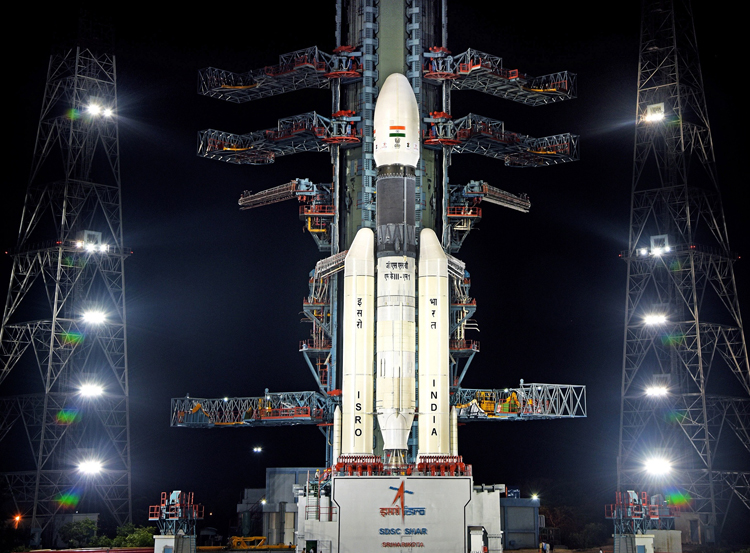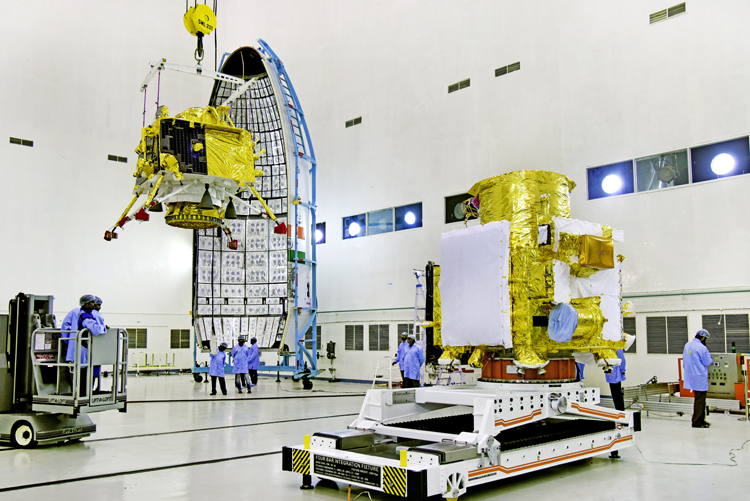INDIAN ARMED FORCES CHIEFS ON
OUR RELENTLESS AND FOCUSED PUBLISHING EFFORTS

SP Guide Publications puts forth a well compiled articulation of issues, pursuits and accomplishments of the Indian Army, over the years

I am confident that SP Guide Publications would continue to inform, inspire and influence.

My compliments to SP Guide Publications for informative and credible reportage on contemporary aerospace issues over the past six decades.
- Prime Minister witnesses 'Bharat Shakti' – a Tri-Services Firing and Manoeuvre Exercise in Pokhran, Rajasthan
- Interim Defence Budget 2024-25 — An Analysis
- Union Defence budget 2024
- Prime Minister Modi Commemorates Indian Navy Day in a Grand Ceremony
- Prime Minister Modi Flies in the LCA Tejas
- New Chapter in India-Italy Defence Ties
- Airpower beyond Boundaries
India's ambitious Moon mission suffers yet another delay
With a technical issue that emerged just about an hour before the launch of Chandrayaan-2, the wait to reach the Moon is still not over for the nation

Scheduled to be launched on July 15, the much-awaited second lunar mission of India, Chandrayaan-2, yet again did not see the dawn of the day. People and media gathered outside the Satish Dhawan Space Centre (SDSC) in Sriharikota post-midnight and several glued to their screens to witness the launch scheduled at 2:51 am live. However, a technical glitch was observed in the launch vehicle system leading to the calling off of Chandrayaan-2. Indian Space Research Organisation (ISRO) took to social media to inform about the problem and called off the mission.
A technical snag was observed in launch vehicle system at 1 hour before the launch. As a measure of abundant precaution, #Chandrayaan2 launch has been called off for today. Revised launch date will be announced later.
— ISRO (@isro) July 14, 2019
There has not been any further information provided by the space agency as yet. The countdown for Chandrayaan-2's launch had started at 6.51 am on July 14, Sunday early morning but was brought to hold at 56:24 minutes to the launch during the wee hours of Monday, July 15. A complete dress rehearsal had also taken place last week.
The countdown for Chandrayaan-2's launch had started at 6.51 am on July 14, Sunday early morning but was brought to hold at 56:24 minutes to the launch during the wee hours of Monday, July 15.
Embarked on a Geosynchronous Launch Vehicle Mark-III (GSLV-Mk-III)-M1, the 978 crore mission was planned to land on the Moon in early September after several orbital phases. The three-stage vehicle, GSLV Mk-III, is India's most powerful launcher to date and is capable of launching 4-ton class of satellites to the Geosynchronous Transfer Orbit (GTO). While GSLV III is the heaviest vehicle in ISRO's stable, it is noteworthy that the vehicle has had only two flights to date.

Unlike the first lunar mission in 2008 which only involved remote sensing while orbiting, Chandrayaan-2 was attempting to put a Rover on the Moon through the landing spacecraft, Lander, to study the surface of the Earth's sole natural satellite. The successful Chandrayaan-1 launched in 2008 made over 3,400 orbits around the Moon and was operational for 312 days. Chandrayaan-1 is also claimed to have carried the first search of water on the Moon using radars. For Chandrayaan-2, the GSLV MK-III-M1 will be carrying an Orbiter, Lander and a Rover in a mission aiming to unveil lunar secrets.
Unlike the first lunar mission in 2008 which only involved remote sensing while orbiting, Chandrayaan-2 was attempting to put a Rover on the Moon through the landing spacecraft, Lander, to study the surface of the Earth's sole natural satellite.
After separating from the Orbiter and following controlled descent, the Lander (named Vikram) will head for a soft landing at a specified place on the surface of the Moon, and release the Rover (named Pragyan). The instruments on the Rover will analyze the surface and send back data. The Chandrayaan-2 orbiter will move around the Moon for remote sensing, while the payloads will gather information on lunar topography, mineralogy, elemental abundance, lunar exosphere and signatures of hydroxyl and water-ice.While Chandrayaan-1 established the presence of water/hydroxyl on the Moon, Chandrayaan-2 is intended to analyze mineral composition and map the Moon's terrain. Also with this mission, ISRO plans to land on the Moon's South Pole, which has not been explored by other countries yet
However, it cannot be ignored that this is not the first time that the nation's second Moon mission has witnessed a delay. There have been nearly seven instances now in the series of delay that Chandrayaan-2 has been facing.
Experts are appreciating the move to call off the mission instead of rushing to send it off with anomalies, stating how big a mission this is and cannot be risked with any minor mistake more so after the launch.
However, it cannot be ignored that this is not the first time that the nation's second Moon mission has witnessed a delay. There have been nearly six-seven instances now in the series of delay that Chandrayaan-2 has been facing.
A significant factor to note here is the "clear 14 days" window that is needed for the launch as the systems for Chandrayaan-2 are powered by solar energy. Hence clear sunlight for 14 days with the Earth, Moon, and the Sun positioned in a specific appropriate place is what is required for the launch.
Envisioned way back in 2007, Chandrayaan-2 was originally aimed for a launch in 2013 as an Indo-Russian venture. However, Russia pulled out of the deal and the take-off had its first miss. March 2018 was then decided for the launch of India's second Moon mission but was further shifted to April 23, 2018, in need of a suitable launch window. However, that too was changed to October due to more days required for certain necessary tests. But October was missed too and January 2019 was picked for the launch. It is almost unbelievable that there was again a further delay and apparently due to some troubles with the re-throttling of the lander, the date was further shifter to April 2019. But as fate would have it, during trials ahead of the expected launch in April 2019, the landing spacecraft, Vikram, was damaged. Two of the four damaged 'legs' of this spacecraft required repair, which has forced postponement of the mission to July 15, 2019. However, despite all successful tests, prayers, preparations and much hype around Chandrayaan-2 which looked set for the launch, there has not been a success with the launch and we need to wait more. It is uncertain if the wait will further be of somedays, weeks, months or more. It has been over a decade since Chandrayaan-1 and it is only hoped that it won't become a decade for the nation's wait to soft-land a robotic mission on the lunar surface.
A significant factor to note here is the "clear 14 days" window that is needed for the launch as the systems for Chandrayaan-2 are powered by solar energy. Hence clear sunlight for 14 days with the Earth, Moon, and the Sun positioned in a specific appropriate place is what is required for the launch.
The delays are further risking the chances of India to become the fourth country in the world to land a spacecraft on the Moon after Russia, US, and China.





